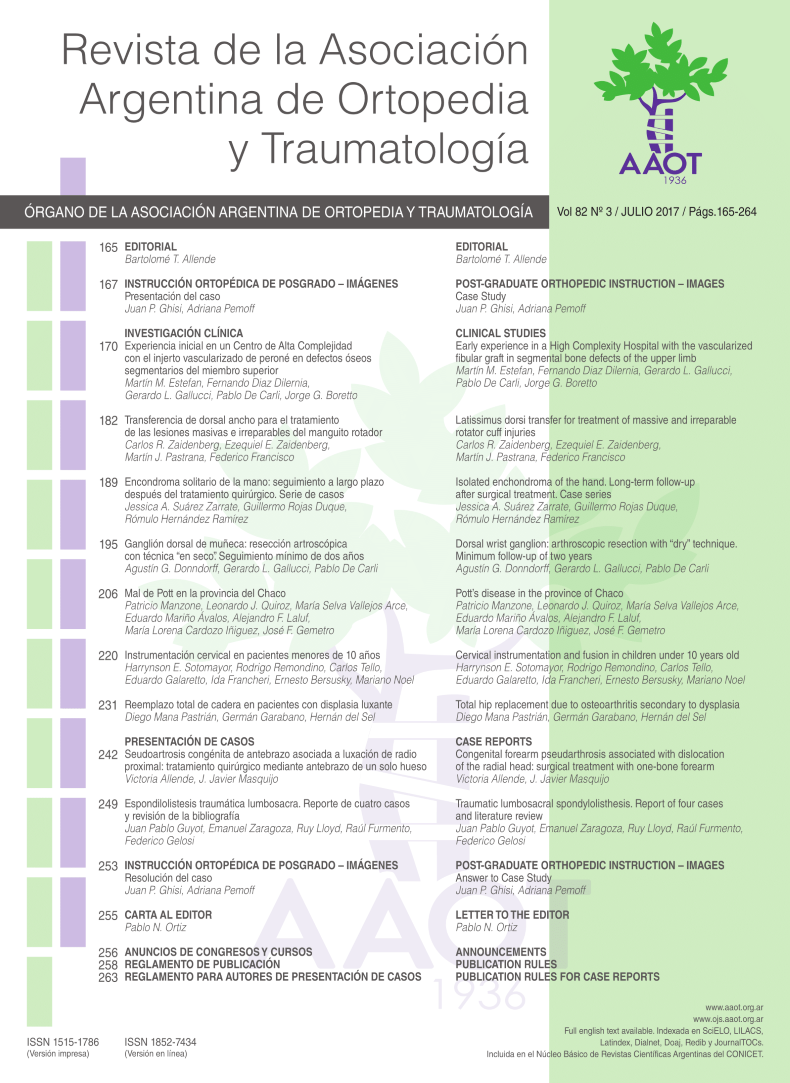Latissimus dorsi transfer for treatment of massive and irreparable rotator cuff injuries.
Main Article Content
Abstract
Downloads
Metrics
Article Details

This work is licensed under a Creative Commons Attribution-NonCommercial-ShareAlike 4.0 International License.
Manuscript acceptance by the Journal implies the simultaneous non-submission to any other journal or publishing house. The RAAOT is under the Licencia Creative Commnos Atribución-NoComercial-Compartir Obras Derivadas Igual 4.0 Internacional (CC-BY-NC.SA 4.0) (http://creativecommons.org/licences/by-nc-sa/4.0/deed.es). Articles can be shared, copied, distributed, modified, altered, transformed into a derivative work, executed and publicly communicated, provided a) the authors and the original publication (Journal, Publisher and URL) are mentioned, b) they are not used for commercial purposes, c) the same terms of the license are maintained.
In the event that the manuscript is approved for its next publication, the authors retain the copyright and will assign to the journal the rights of publication, edition, reproduction, distribution, exhibition and communication at a national and international level in the different databases. data, repositories and portals.
It is hereby stated that the mentioned manuscript has not been published and that it is not being printed in any other national or foreign journal.
The authors hereby accept the necessary modifications, suggested by the reviewers, in order to adapt the manuscript to the style and publication rules of this Journal.
References
1. Burkhart SS. Arthrocopic treatment of massive rotator cuff tears. Clinical results and biomechanical rationale . Clin Orthop Relat Res. 1991; 267: 45-56
2. Cofield RH. Rotator cuff disease of the shoulder. J Bone Joint Surg Am. 1985;67:974–9.
3. Neer CS. Anatomy of shoulder reconstruction. In: Neer CS, ed. Shoulder reconstruction. Philadelphia, etc: W. B. Saunders Company, 1990:1-39.
4. Ozaki J, Fujimoto S, Masuhara K, Tamai S, Yoshimoto S. Reconstruction of chronic massive rotator cuff tears with synthetic materials. Clin Orthop Relat Res 1986;202:173-83.
5. Rockwood Jr CA, Williams Jr GR, Burkhead Jr WZ: Debridement of degenerative, irreparable lesions of the rotator cuff. J Bone Joint Surg 77A:857–866, 1995.
6. Gerber C, Maquieira G, Espinosa N. Latissimus dorsi transfer for the treatment of irreparable rotator cuff tears. J Bone Joint Surg Am. 2006;88:113-20.
7. Scheibel M, Lichtenberg S, Habermeyer P. Reversed arthroscopic subacromial decompression for massive rotator cuff tears. J Should Elb Surg. 2005;13:272–8.
8. Constant CR, Murley AHG: A clinical method functional assess ment of the shoulder. Clin Orthop 214:160–164, 1987.
9. Hamada K, Fukuda H, Mikasa M, Kobayashi Y. Roentgenographic findings in massive rotator cuff tears. A long-term observation. Clin Orthop Relat Res. 1990; 254:92-6.
10. Gerber C, Vinh TS, Hertel R, Hess CW. Latissimus dorsi transfer for the treatment of massive tears of the rotator cuff. A preliminary report. Clin Orthop Relat Res. 1988;232:51–61
11. Vanhove B, Beugnies A: Grammont’s reverse shoulder prosthesis for rotator cuff arthropathy: A retrospective study of 32 cases. Acta Orthop Belg 2004; 70(3):219-225.
12. Walch G, Wall B, Mottier F: Complications and revision of the reverse prosthesis: A multicenter study of 457 cases, in Walch G, Boileau P, Molé P, Favard L, Lévigne C, Sirveaux F, eds: Reverse Shoulder Arthroplasty: Clinical Results, Complications, Revision. Complications in Reverse Total Shoulder Arthroplasty. Montpellier, France, Sauramps Médical, 2006, pp 335-352.
13. Gerber C, Pennington SD, Nyffeler RW: Reverse total shoulder arthroplasty. J Am Acad Orthop Surg 2009;17(5):284-295.
14. l’Episcopo JB. Tendon transplantation in obstetrical paralysis. Am J Surg 1934; 25:122–125.
15. Berth A, NeumannW, Awiszus F, Pap G. Massive rotator cuff tears: functional outcome after debridement vs arthroscopic partial repair. J Orthop Traumatol. 2010;11:13–20.
16. Audenaert E, Van Nuffel J, Schepens A, Verhelst M, Verdonk R. Reconstruction of massive rotator cuff lesions with a synthetic interposition graft: a prospective study of 41 patients. Knee Surg Sports Traumatol Arthrosc. 2006;14:360–4.
17. Warner JJ, Parsons Im IV. Latissimus dorsi tendon transfer: a comparative analysis of primary and salvage reconstruction of massive, irreparable rotator cuff tears. J Shoulder Elbow Surg 2001;10: 514-21.
18. El-Azab HM, Rott O, Irlenbusch U. Long-term follow-up after lattisimus dorsi transfer for irreparable posterosuperior rotator cuff tears. J Bone Joint Surg Am. 2015 Mar 18;97(6):462-9.

